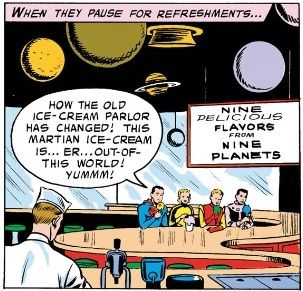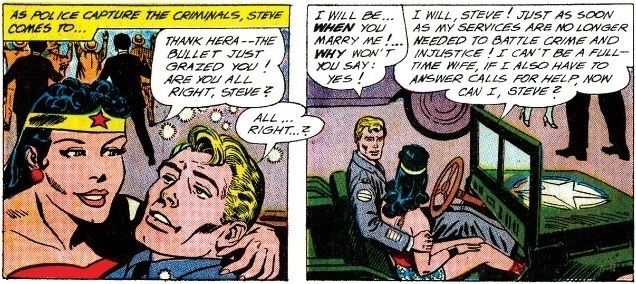“Sometimes, it’s nice to watch something simplistic,” a relative of mine remarked after we had rewatched The Harvey Girls, a 1946 movie musical starring Judy Garland. This comment caught me by surprise, because I didn’t view The Harvey Girls as simplistic at all. Its emphasis on marriage as a (good) woman’s ultimate goal, its villainous depiction of women who are not as devout and virginal as the Harvey Girls, and its reverse Grease ending all promote a particular kind of message that was sanitized and approved by a particular kind of person for a particular kind of audience.
I could go on about the social messages in classic Hollywood musicals, but since this is Book Riot and not Movie Riot (for the record, I would totally write for Movie Riot, too), let’s shift the conversation to another medium that people often think of as “simplistic.”
In some ways, comic books have gotten progressively more complex since they first assumed modern form in the late 1930s. They learned to tackle more serious subject matter and built up an ever larger, ever more convoluted continuity. In the ’60s, if I said I read X-Men comics, you’d know immediately which book I meant: X-Men. Now, I could mean X-Men, X-Factor, X-Force, X-Men Gold, X-Men Blue, New Mutants, and probably some other teams I’m forgetting. Meanwhile, if I try to find a particular Hawkeye comic, I am confronted with Hawkeye, All-New Hawkeye, the other All-New Hawkeye, the other Hawkeye…you get the picture.
So, yes, the comic book industry was more straightforward back then. So were the comics. But they are simplistic in the same way The Harvey Girls is: lots of bright colors and fluff to make the social norms go down.
Whenever a hero meets an alien race, that race is generally either monstrous or white people. The Skrulls and the Kree, Marvel’s best-known alien rivalry, exemplify this. The Skrulls are lizard-like creatures with pointed ears and green skin; the Kree look like suburban dads in Star Trek cosplay. Earth’s future was depicted in the same way: when Superboy travels to the far future with the Legion of Super-Heroes for the first time, they meet nothing but white people and generally act like this is an episode of Leave It to Beaver. They even take him to an easily recognizable ice cream parlor, for crying out loud.

I’m not suggesting that the creators responsible for these comics all sat down at their desks in the morning and went, “Today I am going to promote my heteronormative, racist, sexist agenda! Nyahahahaha!” As always, it’s more complicated than that. While some creators may have been actively malicious, most of them, as the beneficiaries of the heteronormative, racist, sexist society they lived in, were probably just acting on instinct. It was natural for them to create a homogeneous alien world/future to match the homogeneous present they already portrayed in their work. Any creators who did want to be more inclusive would have been stopped by the censors. (Look what happened when a publisher tried to feature a Black astronaut in the early ’60s. The scandal!)
What message does this send?
Most superheroes in the ’50s and ’60s are white men who want nothing more than to settle down with a nice girl, and they are anguished when circumstances stand between them and the women they love. As for the women, they all really just want the chance to quit their jobs and settle down. That includes independent, career-oriented women like Lois Lane and Wonder Woman. There is never any question that being a good wife means abandoning all pursuits not directly related to the husband’s happiness.

What message does this send?
The more “simplistic” a comic is, the stronger the demarcation between good and evil. You have your heroes, who consist of people (mostly men) in funny costumes, the police, the military, and the American government. And you have your villains, who consist of people (mostly men) in funny costumes and foreign countries whose policies America disagreed with. This was, at least in part, due to the Comics Code Authority preventing more nuanced portrayals of these entities.
In Flash #124, for instance, when a supervillain leaves prison, the Flash is suspicious, even though the man has served his sentence and been legally paroled. Flash takes it upon himself to harass his old foe based on nothing more than personal dislike. Of course, the villain has indeed returned to a life of crime, justifying Flash’s unfair behavior.

What message does this send?
I could go on, but you get the point. Even the goofiest comics were made by flawed humans with opinions, values, beliefs, and prejudices. Those humans were in turn influenced and constrained by other humans with deadlines to meet, profits to make, and people to please. All of that affects the final product, imbuing it with meanings and messages both intentional and incidental. So when someone describes a comic or anything else as “simplistic,” what they really mean is that they haven’t thought critically about it.
Maybe that’s because they don’t realize there is anything to be critical of. Maybe they, like the media creators themselves, are part of the dominant culture that is glorified in these comics and thus view them as ideals to aspire to. But such messages only appear simplistic if you are part of or agree with that dominant culture.
On the other hand, maybe our hypothetical reader just doesn’t feel like thinking critically right now. And there’s nothing wrong with that. Comics are, first and foremost, entertainment. It’s okay to turn off the analytical part of your brain and just enjoy something. Me, I think my off switch is broken. (As if you couldn’t tell from the fact that I turned an innocuous comment into an 1100-word article.)
You’d think this would be tiring, but I’m nosy enough to enjoy it. I want to know everything about everybody. Pivoting back to The Harvey Girls, I remember going to the library after watching that movie for the first time and getting all excited when I found a book about the real Harvey Girls. Finally, I could learn more, not just what 1940s Hollywood wanted me to know! The same thing happened with another musical, The Unsinkable Molly Brown. And, if I was ever disappointed that John Smith was not the romantic, handsome hero Disney’s Pocahontas portrayed him as, that disappointment was subsumed by the pleasure of learning the truth (even if, in this case, the truth was pretty ugly). I was a fun kid.
Do you have to pick apart every single thing you ever read and watch? Of course not. But sometimes — just once in a while — it’s a good idea to look at what you’re consuming with an analytical eye and ask yourself: Why is this here? Are some elements (or some people) missing? If so, why is that?
What message does this send?
